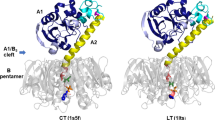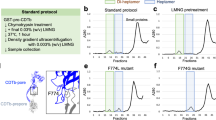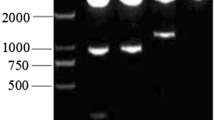Abstract
The thermal denaturation of the chimeric protein toxin known as sCD4(178)-PE40 (sCD4-PE40) was studied using differential scanning calorimetry (DSC). sCD4-PE40 consists of HIV-binding domains of the T-cell membrane protein known as CD4 and the cytotoxic domains of Pseudomonas exotoxin A (PE40). sCD4-PE40 undergoes two DSC transitions. An endothermic transition associated with unfolding of the CD4 and PE40 components occurs at approximately 46°C in buffered saline at pH 6.5. An exothermic transition associated with precipitation of unfolded protein occurs at higher temperatures. Both transitions are irreversible. DSC studies of solutions of pH 5.0 to 9.5 indicate that sCD4-PE40 shows maximal thermal stability at around pH 6.5. Variable pH experiments are also presented on solutions of sCD4(183) and PE40 revealing how these components denature as independent structural entities. sCD4(183) denaturation occurs at significantly higher temperatures than does the CD4 component of sCD4-PE40. PE40 denaturation occurs at the same temperatures as sCD4-PE40. These results suggest that the native CD4 and PE40 components are independent and non-interacting entities in the chimeric sCD4-PE40 molecule and that unfolding of the less-stable PE40 component induces unfolding of the CD4 component. These destabilizing interdomain interactions of sCD4-PE40 are in contrast to the stabilizing interactions which apparently exist in wild-type Pseudomonas exotoxin A between its PE40 domains and the cell binding domain of the native toxin (analogous to the CD4 component in sCD4-PE40). Reasons are discussed why the type of interdomain interactions observed for sCD4-PE40 might be the norm for chimeric proteins.
Similar content being viewed by others
REFERENCES
I. Pastan, V. Chaudhary, and D. J. FitzGerald. Recombinant toxins as novel therapeutic agents. Annu. Rev. Biochem. 61:331–354 (1992).
E. A. Berger, T. R. Fuerst, and B. Moss. A soluble recombinant polypeptide comprising the amino-terminal half of the extracellular region of the CD4 molecule contains an active binding site for human immunodeficiency virus. Proc. Natl. Acad. Sci. USA. 85:2357–2361 (1988).
V. K. Chaudhary, T. Mizukami, T. R. Fuerst, D. J. FitzGerald, B. Moss, I. Pastan, and E. A. Berger. Selective killing of HIV-infected cells by recombinant human CD4-Pseudomonas exotoxin hybrid protein. Nature. 335:369–372 (1988).
J. Hwang, D. J. FitzGerald, S. Adhya, and I. Pastan. Functional domains of Pseudomonas exotoxin identified by deletion analysis of the gene expressed in E. coli. Cell. 48:129–136 (1987).
V. S. Allured, R. J. Collier, S. F. Carroll, and D. B. McKay. Structure of exotoxin A of Pseudomonas aeruginosa at 3.0-Ångstrom resolution. Proc. Natl. Acad. Sci. USA. 83:1320–1324 (1986).
B. H. Iglewski and D. Kabat. NAD-dependent inhibition of protein synthesis by Pseudomonas aeruginosa toxin. Proc. Natl. Acad. Sci. USA. 72:2284–2288 (1975).
P. Ashorn, B. Moss, J. N. Weinstein, V. K. Chaudhary, D. J. FitzGerald, I. Pastan, and E. A. Berger. Elimination of infectious human immunodeficiency virus from human T-cell cultures by synergistic action of CD4-Pseudomonas exotoxin and reverse transcriptase inhibitors. Proc. Natl. Acad. Sci. USA. 87:8889–8893 (1990).
J. F. Brandts, C. Q. Hu, and L.-N. Lin. A simple model for proteins with interacting domains. Applications to scanning calorimetry data. Biochemistry. 28:8588–8596 (1989).
G. Ramsay and E. Freire. Linked thermal and solute perturbation analysis of cooperative domain interactions in proteins. Structural stability of diphtheria toxin. Biochemistry. 29:8677–8683 (1990).
E. Freire and R. L. Biltonen. Statistical mechanical deconvolution of thermal transitions in macromolecules. I. Theory and application to homogeneous systems. Biopolymers. 17:463–479 (1978).
E. Freire, K. P. Murphy, J. M. Sánchez-Ruiz, M. L. Galisteo, and P. L. Privalov. The molecular basis of cooperativity in protein folding. Thermodynamic dissection of interdomain interactions in phosphoglycerate kinase. Biochemistry. 31:250–256 (1992).
R. M. Izatt and J. J. Christensen. Heats of proton ionization, pKa, and related thermodynamic quantities. In G. D. Fasman (ed.) CRC Handbook of Biochemistry and Molecular Biology, 3rd Edition, Physical and Chemical Data Volume I, CRC Press, Boca Raton, FL, 1985, pp. 151–269.
N. E. Good, G. D. Winget, W. Winter, T. N. Connolly, S. Izawa, and R. M. M. Singh. Hydrogen ion buffers for biological research. Biochemistry. 5:467–477 (1966).
D. D. Perrin and B. Dempsey. Buffers for pH and Metal Ion Control, Chapman and Hall, London. 1974.
T. J. McQuade, T. W. Pitts, and W. G. Tarpley. A rapid solution immunoassay to quantify binding of the human immunodeficiency virus envelope glycoprotein to soluble CD4. Biochem. Biophys. Res. Commun. 163:172–176 (1989).
P. L. Privalov and N. N. Khechinashvili. A thermodynamic approach to the problem of stabilization of globular protein structure: A calorimetric study. J. Mol. Biol. 86:665–684 (1974).
J. X. Jiang and E. London. Involvement of denaturation-like changes in Pseudomonas exotoxin A hydrophobicity and membrane penetration determined by characterization of pH and thermal transitions. J. Biol. Chem. 265:8636–8641 (1990).
S. Lory and R. J. Collier. Expression of enzymic activity by exotoxin A from Pseudomonas aeruginosa. Infect. Immun. 28:494–501 (1980).
E. Freire and K. P. Murphy. Molecular basis of co-operativity in protein folding. J. Mol. Biol. 222:687–698 (1991).
Author information
Authors and Affiliations
Additional information
Brian E. Collins: B.E.C.'s contribution was made while he was a summer intern at The Upjohn Company.
Rights and permissions
About this article
Cite this article
Davio, S.R., Kienle, K.M. & Collins, B.E. Interdomain Interactions in the Chimeric Protein Toxin sCD4(178)-PE40: A Differential Scanning Calorimetry (DSC) Study. Pharm Res 12, 642–648 (1995). https://doi.org/10.1023/A:1016239004714
Issue Date:
DOI: https://doi.org/10.1023/A:1016239004714




